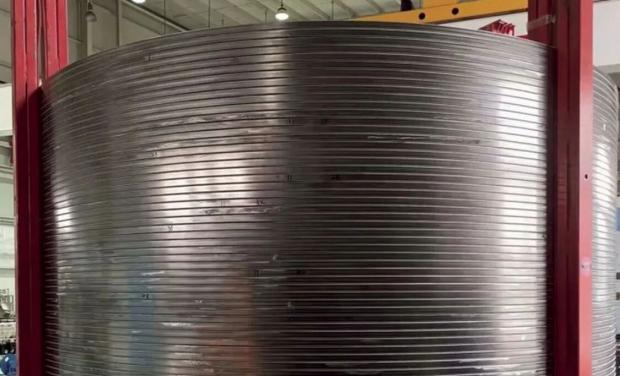
Breaking News
 THIS IS A FIRST FOR ME AND MY HOMESTEAD
THIS IS A FIRST FOR ME AND MY HOMESTEAD
 6 friends, 6 units, 1 lot: each owns their dream home for $800/month
6 friends, 6 units, 1 lot: each owns their dream home for $800/month
 Trump & Putin Meet In Alaska, Melania's Epstein Lawsuit & Netanyahu TROLLS Iran | PBD Podcast 63
Trump & Putin Meet In Alaska, Melania's Epstein Lawsuit & Netanyahu TROLLS Iran | PBD Podcast 63
Top Tech News
 Chinese Scientists Produce 'Impossible' Steel to Line Nuclear Fusion Reactors in Major Break
Chinese Scientists Produce 'Impossible' Steel to Line Nuclear Fusion Reactors in Major Break
 1,000 miles: EV range world record demolished ... by a pickup truck
1,000 miles: EV range world record demolished ... by a pickup truck
 Fermented Stevia Extract Kills Pancreatic Cancer Cells In Lab Tests
Fermented Stevia Extract Kills Pancreatic Cancer Cells In Lab Tests
 3D printing set to slash nuclear plant build times & costs
3D printing set to slash nuclear plant build times & costs
 You can design the wheels for NASA's next moon vehicle with the 'Rock and Roll Challenge
You can design the wheels for NASA's next moon vehicle with the 'Rock and Roll Challenge
 'Robot skin' beats human reflexes, transforms grip with fabric-powered touch
'Robot skin' beats human reflexes, transforms grip with fabric-powered touch
 World's first nuclear fusion plant being built in US to power Microsoft data centers
World's first nuclear fusion plant being built in US to power Microsoft data centers
 The mitochondria are more than just the "powerhouse of the cell" – they initiate immune...
The mitochondria are more than just the "powerhouse of the cell" – they initiate immune...
 Historic Aviation Engine Advance to Unlock Hypersonic Mach 10 Planes
Historic Aviation Engine Advance to Unlock Hypersonic Mach 10 Planes
 OpenAI CEO Sam Altman Pitches Eyeball-Scanning World ID to Bankers
OpenAI CEO Sam Altman Pitches Eyeball-Scanning World ID to Bankers
Chinese Scientists Produce 'Impossible' Steel to Line Nuclear Fusion Reactors in Major Break

Creating such a material with steel is a feat previously thought impossible by experts working on the famous ITER project in France, of which the leader of this new steel project was a part.
The International Thermonuclear Experimental Reactor (ITER) project brought together experts from 35 nations to build the world's largest nuclear fusion reactor in southern France.
Nuclear fusion is considered the ideal future energy source. It works by creating a thermonuclear reaction, the same process that powers our Sun, and containing it via superconducting magnets for brief periods of time to generate zero-emission energy in vast quantities.
It's one of a handful of truly era-defining technologies humans are working towards, and physicists have faced numerous challenges in developing it. At the heart of a fusion reactor are superconducting magnets coated in a jacket of cryogenic steel. The steel must be capable of protecting the magnets from -516°F temperatures, but also of withstanding the incredible forces generated by them.
Li Laifeng, at the Chinese Academy of Sciences' (CAS) Technical Institute of Physics and Chemistry in Beijing, observed how this steel could withstand the pressures of ITER, but future, more powerful—also more compact reactors—would need more advanced steel.
This took Li on a 12-year journey to create what ITER experts thought was impossible.
Reporting on those early days to a Chinese science outlet, Science Daily, Li said that Western experts in the field thought that '316LN austenitic stainless steel,' a specialized alloy designed for extreme conditions and used in ITER and capable of withstanding 11.8 Tesla magnetic fields, would be sufficient for future fusion projects.
Li doubted that, and allied with top scientists in the field of cryogenics and materials sciences, believed it was worth pursuing a better alloy.
In 2021, the CAS Institute of Plasma Physics in Hefei province set the benchmark for what the country's own national fusion program would require to be successful—benchmarks that 316LNa steel could not meet.
Eventually, Li Laifeng was in charge of the High-Strength Steel Research Alliance, comprising 4 scientific institutes and 13 enterprises. According to South China Morning Post, "China high-strength low-temperature steel No. 1 (CHSN01) successfully met the institute's benchmarks, showing the capability of resisting 20 Tesla fields, 1,300 megapascals of stress, and the low temperatures which protect the device from the heat generated by nuclear fusion.

 I CAN BELIEVE IT'S NOT BUTTER
I CAN BELIEVE IT'S NOT BUTTER


